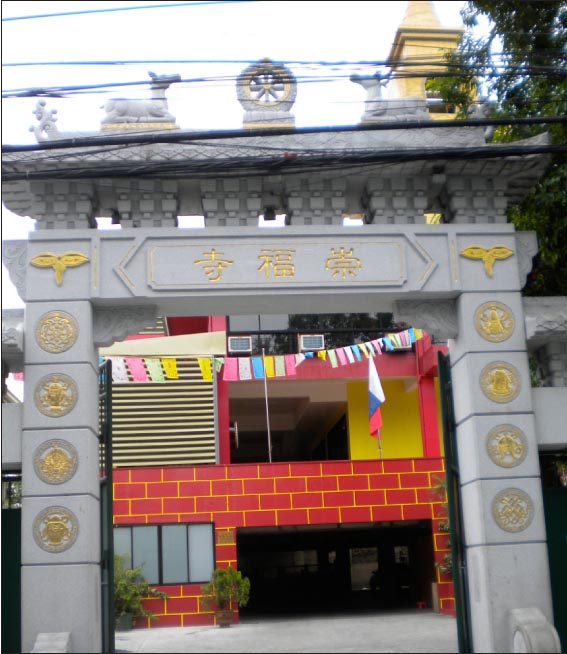This is the second of a series about the Chinese Buddhist temples of the Philippines. There are around 36 in different parts of the country. Much of the information is from a thesis of Venerable Chuanmiao (Hsuan Chuang University, 2008), a Buddhist monk affiliated with the Thousand Buddha Temple in Quezon City.
In the first series, the author originally referred to the religious women in Buddhist temples as caigu (菜姑). Since this term might be considered disrespectful by some, the editors decided to replace it with “nun.”
Upon further dialogue with the author, however, it emerged that nuns refer to the ordained (with heads shaved) Buddhist monastics known in Chinese as biqiuni (比丘尼) and addressed as fashi (法師)). It would be more appropriate to refer to the unshaven religious women as “lay sisters.”—Ed.
2. Chong Hoc Temple (崇福寺)
57 Williams St., Pasay City (Tels.: 831-6343, 775-5739)
This temple is spiritually linked to the temple of the same name in Quanzhou, Fujian.
Ven. Yuanguo (元果), who became a monk in Quanzhou at age 12, visited Manila in 1975 and found the resources to buy an old house on Williams St., Pasay. He converted it into a temple, which opened in 1978 with a main shrine dedicated to the Thousand Hands Thousand Eyes Guanyin.
In 1993, Yuanguo invited Ven. Liren (理任) to leave the mother temple in Quanzhou and run the Manila temple. Liren stayed until 1999, when he was recalled to Quanzhou and eventually became abbot there. The temple’s lay board, using Yuanguo’s contacts in Hong Kong, invited Zhengzhe to take charge of the temple in 2001.
Zhengzhe was abbot of his own temple in Hong Kong, Ji Le (极樂寺), but since 1997, had also taken over Cebu’s Buddha Light Temple (佛光寺), founded by a Dharma brother of his master in Fujian, Shanyang (善揚).
In 2003, he also accepted responsibility for the Bun Su Temple in Pasay. Thus, although largely based in Hong Kong, he became abbot of three temples in the Philippines.

Main buildings. When he took over the temple in 2001, Zhengzhe put up the present buildings. The parking lot is street level. Two floors were built above it: the shrine to Guanyin and the ancestral altar on the second, the Buddhas of the five directions on the top floor.
Leadership and primary activities. Zhengzhe is not always in residence. But seven monks reside here and manage temple activities. Among the Buddhist feast days, they emphasize the three-day chanting of Buddha’s thousand names from the 12th-15th of the first lunar month.
The regular chanting service of the temple’s devotees is offered the first Sunday of each month. The temple also manages a charity fund for relief work after natural calamities.
Available to the community are services of resident monks with special skills. One monk operates a Chinese medicine clinic, and another offers Shaolin kungfu classes at the Bun Su Temple. — First published in Tulay Fortnightly, Chinese-Filipino Digest 25, nos. 15-16 (January 15-February 4, 2013): 23-24.